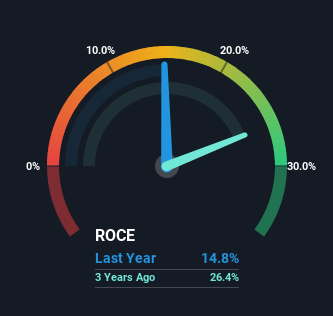- Taiwan
- /
- Semiconductors
- /
- TWSE:6176
Here's What's Concerning About Radiant Opto-Electronics' (TWSE:6176) Returns On Capital
If you're not sure where to start when looking for the next multi-bagger, there are a few key trends you should keep an eye out for. Typically, we'll want to notice a trend of growing return on capital employed (ROCE) and alongside that, an expanding base of capital employed. Ultimately, this demonstrates that it's a business that is reinvesting profits at increasing rates of return. Although, when we looked at Radiant Opto-Electronics (TWSE:6176), it didn't seem to tick all of these boxes.
Return On Capital Employed (ROCE): What Is It?
If you haven't worked with ROCE before, it measures the 'return' (pre-tax profit) a company generates from capital employed in its business. Analysts use this formula to calculate it for Radiant Opto-Electronics:
Return on Capital Employed = Earnings Before Interest and Tax (EBIT) ÷ (Total Assets - Current Liabilities)
0.15 = NT$5.7b ÷ (NT$61b - NT$22b) (Based on the trailing twelve months to December 2023).
Therefore, Radiant Opto-Electronics has an ROCE of 15%. In absolute terms, that's a satisfactory return, but compared to the Semiconductor industry average of 8.3% it's much better.
View our latest analysis for Radiant Opto-Electronics

In the above chart we have measured Radiant Opto-Electronics' prior ROCE against its prior performance, but the future is arguably more important. If you'd like, you can check out the forecasts from the analysts covering Radiant Opto-Electronics for free.
What The Trend Of ROCE Can Tell Us
In terms of Radiant Opto-Electronics' historical ROCE movements, the trend isn't fantastic. To be more specific, ROCE has fallen from 20% over the last five years. And considering revenue has dropped while employing more capital, we'd be cautious. If this were to continue, you might be looking at a company that is trying to reinvest for growth but is actually losing market share since sales haven't increased.
On a side note, Radiant Opto-Electronics has done well to pay down its current liabilities to 37% of total assets. So we could link some of this to the decrease in ROCE. Effectively this means their suppliers or short-term creditors are funding less of the business, which reduces some elements of risk. Some would claim this reduces the business' efficiency at generating ROCE since it is now funding more of the operations with its own money.
In Conclusion...
In summary, we're somewhat concerned by Radiant Opto-Electronics' diminishing returns on increasing amounts of capital. Yet despite these poor fundamentals, the stock has gained a huge 143% over the last five years, so investors appear very optimistic. In any case, the current underlying trends don't bode well for long term performance so unless they reverse, we'd start looking elsewhere.
Radiant Opto-Electronics does have some risks though, and we've spotted 1 warning sign for Radiant Opto-Electronics that you might be interested in.
For those who like to invest in solid companies, check out this free list of companies with solid balance sheets and high returns on equity.
New: AI Stock Screener & Alerts
Our new AI Stock Screener scans the market every day to uncover opportunities.
• Dividend Powerhouses (3%+ Yield)
• Undervalued Small Caps with Insider Buying
• High growth Tech and AI Companies
Or build your own from over 50 metrics.
Have feedback on this article? Concerned about the content? Get in touch with us directly. Alternatively, email editorial-team (at) simplywallst.com.
This article by Simply Wall St is general in nature. We provide commentary based on historical data and analyst forecasts only using an unbiased methodology and our articles are not intended to be financial advice. It does not constitute a recommendation to buy or sell any stock, and does not take account of your objectives, or your financial situation. We aim to bring you long-term focused analysis driven by fundamental data. Note that our analysis may not factor in the latest price-sensitive company announcements or qualitative material. Simply Wall St has no position in any stocks mentioned.
About TWSE:6176
Radiant Opto-Electronics
Engages in the manufacture and sale of backlight modules and light guide plates for liquid crystal display panels (LCD) in Asia, Europe, and the United States.
Flawless balance sheet and good value.
Similar Companies
Market Insights
Community Narratives




